WORLD CLASS COACHING
30 Transition Rondos
By Luca Bertolini
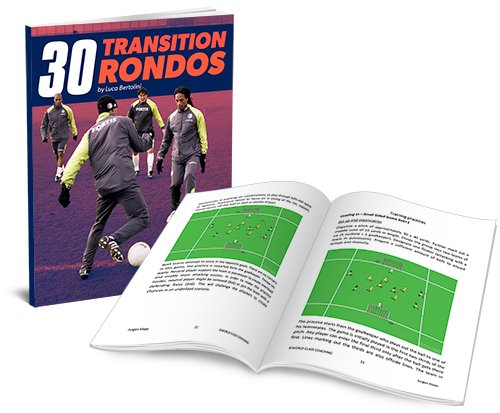
Table of Contents
PART ONE
INTRODUCTION
THE KEY POINTS WHEN PRACTICING RONDOS
SINGLE GRID TRANSITION RONDOS
PART TWO
TWO GRID RONDOS
PART THREE
THREE-GRID RONDOS
PART FOUR
FOUR-GRID RONDOS
Introduction: About Rondos
Introduction: the Transition Phases
In every kind of football match, teams are involved in possession and non-possession phases of play, but in modern soccer, two intermediate phases are more decisive than possession or defensive phases: the transitions from defense to attack (a team wins the ball from their opponents) and the transition from attack to defense (a team loses the ball to their opponents).
To be a successful team means to be able to exploit the unbalanced defense of the opposition when the ball is won or to be able to close the space and to limit the passing options for the opposition when the ball is lost. The faster a team is able to react during the transition phases, the more successful it can be.
Transition means the time span between the ball possession phase and the non-possession phase and vice versa.
The goal for every player and every team, of course, is to play the transition between the two phases as quickly as possible, to work as a dynamic and reactive team, to be ready to start the possession phase with a counter attack or to close all the spaces in case of loss of the ball.
Transition from Defense to Attack
The tactical situation must be exploited as quickly as possible when the possession is recovered. The first pass made should be forward before the opposition is able to close the passing lanes and mark the teammates near the ball.
The players are asked to be skilled with quick reactions, anticipation, technical accuracy, visual awareness of the space, clever movements and good decision making, and physical speed and speed of thought.
Then the aim must be to coach the players for the transitions from defense to attack at high intensity so they learn to play at high speeds. The faster they are able to play this transition, the more successful the team will be.
An excellent transition to attack phase coaching allows the players to understand how to arrive on the ball first, to exploit the "second times of the ball" effectively and to be able to attack in front of the goal.
Transitions from attack to defense
After losing the ball, it is important to apply immediate pressure against the opposition and against the first player in possession before he can get his head up to dribble or to pass forward; the player who lost the possession and one more close to the area around the ball should react immediately. All the other players should mark the potential receivers, anticipating their positioning and movements and closing the further passing lanes.
These defensive movements must be carried out with the correct timing for players to be coordinated as a team, at high intensity and speed to be sure that the opposition is unable to exploit the team’s lack of balance and to play fast counter attacks.
If "the best way to defend is to attack,” to defend means to press the opponents during the building up and possession phases and to improve the attacking quality level of the team. An example is given by the "rule of 6 seconds" that Guardiola applied to his Bayern Munich and Barcelona.
In case of loss of possession, high and strong pressure was immediately taken to prevent the opponent from dribbling the ball forward and passing to any teammate; the result was the direct or indirect recovery of the ball. This strong but organized tactic in the transition from attack to defense became known as the ‘6 second negative transition’ or the ‘6 second rule.’ If the team failed to win the ball back within that time, then the defense organization started.
This requires, in addition to a valuable ability to read the individual, excellent and lasting practical work to be carried out during training.
From transitions to Rondos
Transitions are quick phases of play with high intensity, changes of rhythm and speed, and quick decision making; all these are characteristics of the rondo exercises. The players and the small groups near the ball must understand and react very quickly and effectively and faster than the opponent, if the possession is won or lost.
These are the reasons why rondos can be useful to coach the first seconds after the possession is won to keep it safe, and the first seconds after the loss of the ball to practice the pressure timing on the first opponent in possession and the closure of the nearest passing lane.
Let's think about Barcelona during Pep Guardiola's seasons; Barcelona used to direct the possession of the opposition towards the sidelines to put pressure easily. As possession was recovered, all the players reacted quickly to find free spaces and passing options.
The goal of the transition to defend was to recover possession immediately through the balance player (Busquets) near the ball, or the quick reaction from all the players who put pressure on the ball to reduce time and space for the opponent in possession.
The first objective as the possession was recovered was to create numerical advantage near the ball and to attack directly or to find the balance player (Busquets) to save the possession and attack inside another space. Wherever the attacking phase was carried out, on the flank or in the middle, quick passing combinations were used to create finishing options. If possible, the first pass was always forward.
Anyway, before being team tactical situations, transitions are player tactical behaviors, when the possession is lost and when the possession is won; and the players near the ball are the first to be involved in these phases of play. This means that the spaces around the ball must be exploited as quickly as possible or closed as quickly as possible.
Then small-sided games and possession games may be used to coach the individual transitions; but we realized in the first volume that these games are too generic and they don't usually have specific tactical requirements, moreover from an individual point of view. To win the ball or to lose the ball during those practices means to play general 1 v 1 or small group duels. I don't want to say they are useless. Of course they are very important for pattern of play, for passing combinations, for the principles of play of the team, and even for the "let them play" principle of training.
As the training sessions must be realistic by reproducing the game situations and if the objective creates the practices, then rondos can be more useful to make every player understand how to react when possession is lost and when possession is won.
If rondos are more specific from a player tactics point of view when in possession, then they can be the same for the defenders even if they are outnumbered; if the defenders win the ball, they can be involved in specific transitions to attack, or to possession we may say, and the player who missed the pass, the ball control or even the timing of freeing from the marker, will be involved in transition to defend.
The transition rondos
First of all during the transitions to attack, let's create players who are to play the ball towards a teammate or into space for a teammate even when they have just recovered the possession. During the transitions to defend the players must run forward quickly to play individual duels or to be placed balanced as soon as possible. The goals of the practices, following the circle transition to defend - transition to attack - transition to defend, must be then:
• Body placement and shape while pressing
• Be focused on the opponent and on the angle and the distance from him
• Close the passing lane and the space to dribble
• Be compact as unit near the ball
• Be focused on the opponent and on the angle and the distance from him
• Defending technique (tackle and intercept the ball)
• Passing (weight, timing and speed) skills
• First touch and control of the ball skills.
• Dribbling of the ball with close control
• Individual defense skills to win 1 v 1 effectively
• Create and exploit spaces and numerical advantage
• Try to unbalance the opposition defense, exploit the weak side or weak area among the opponents
• Manage the numerical disadvantage or the situations with equal number of the players
• Be fast to take advantage of the situation before the opponent can organize the defense phase
• Be balanced during the possession phase
• Pay attention to the distances among the teammates
• Press immediately the first opponent in possession if the ball is lost
If the main goals of the transition to attack inside rondos exercises is to make the possession safe after the recovery of the ball and to keep it as long as possible, the negative transitions could be divided in three different types:
• If the defender is near the ball, he must slow down the attack and prevent the ball being played before trying to win it back
• If the defender is nearer to an opponent without the ball, he then should try to mark the easier passing option for the ball carrier
• If the defender is far from the ball, then he should try to cover the space and close the passing lanes
How to practice transition rondos: the key points.
These are the key points to organize, to practice and to correct a rondo exercise:
• Small sided space: rectangular, square, circular, or grids or any needed shape
• Players must have a specific position inside and outside the shape, depending if they have the possession (outside) or they are defending (inside)
• Sizes of the shapes must be related with the number of players and the objectives of the exercises
• Sizes of the shapes are shorter than those of possession ones, to help the transitions happen
• Balls shall be always available next to the playing area
• Plan the transitions movements for the players who lose the possession or those who win the possession
• Fix a passing and receiving rhythm; it is decisive for the success of a rondo exercise
• Fix a limit of number of touches to manage the ball; they can be different for attacking player and for a neutral player
• Fix a minimum quantity of passes to keep the possession and to gain a point for the team
• Fixed limit of time to recover the possession if needed
What are the Benefits of Coaching a Player with Transition Rondos?
Speed of thought related to the number of touches:
Transition rondos can help the players to understand when and how to move quickly depending on the attacking or defending situations where they are playing.
Thinking about the number of changes of defending or attacking roles of a player during a game, transition rondos can help them to change the role very quickly and very often; so they are supposed to be ready enough to play matches.
Technique, mobility and agility:
The players are asked to be skilled at a good level to keep the possession during a rondo exercise sequence. Playing transition rondos they are asked also to be skilled to manage the ball just after having won the possession and to put pressure just after having lost the possession. As they have to work fast, their motor, mobility and agility skills are improved at the same time.
The passing/receiving sequences are sure without any rule inside 1 or 2 touches rondos and playing in tight spaces forces the players to be fast and to make mistakes also. These attacking and defending situations are repeated again and again, creating transitions to attack and transitions to defend many times during each sequence.
Team tactics:
Transition rondos can be considered a first team tactical work during the possession and non-possession phases; they are also a good training for players’ tactics when in possession and when not in possession. The players must understand how to exploit or to close the passing lanes, when and how to manage the opposition pressure and to put pressure against the opponents in possession and when and how to exploit the weak areas and to cover them.
When the defending players are two or more, the relations and the communication between and among them are very important, as they begin to work as one unit.
Problem solving and creativity:
Rondo tests the player’s skills to problem solve the entire time as they play fast and with high rhythm. The players in possession must be creative to break down the opposition pressure or a defense line, they are always under strong pressure. The defenders must understand how to put pressure and how to organize the recovery of the ball.
Team and body shape are not always perfect, so the players must adapt themselves time to time, even from a motor point of view; they should be able to pass or to recover the ball with any surface of their feet or of their bodies.
Competition and have fun:
Healthy competitions to train the players at high intensity and rhythm are a natural consequence of alternated attacking and defending phase.
PLEASE NOTE!! The transitions phases and sequences are described as Tta (transition to attack) and Ttd (transition to defend).
Single grid transitions rondos

Exercise 1: 2 + 1 v 1 and 1 v 1 transition (1)
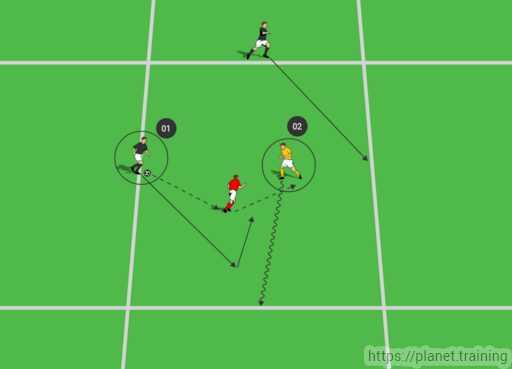
Sequence
Two black players are placed along one of the longer sides of a rectangle and along one of the shorter sides. One neutral player and one defender are placed in the middle of the wide playing space.
The objective for the couple in possession is to pass the ball forward from one longer side toward the other with vertical passes through the neutral player, to move deep to receive from the shorter side behind the defender and to move wide to support the possession phase.
Transitions
Tta: if the defender (2) wins the ball, he must dribble the ball toward the last free side of the rectangle, exploiting the free space to start the sequence from the opposite longer side. Ttd: the last black player in possession (1), before the loss of the possession, becomes defender and he must try to put pressure against the dribbling player in a 1 v 1 duel. The defender can be active until the borderline is overcome, and then he can only try to intercept the passes or to put pressure against the neutral player.
Eye on: interception of the passes, dribble at speed to find a free space, 1 v 1 to win the ball, pressure against the neutral player.
Exercise 2: 2 + 1 v 1 and 1 v 1 transition (2)
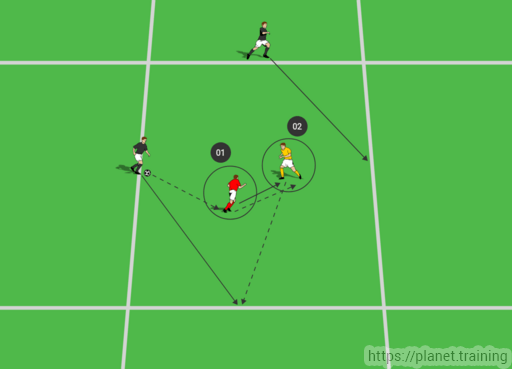
Sequence
Two black players are placed along one of the longer sides of a rectangle and along one of the shorter sides. One neutral player and one defender are placed in the middle of the wide playing space.
The objective for the couple in possession is to pass the ball forward from one longer side toward the other with vertical passes through the neutral player, to move deep to receive from the shorter side behind the defender and to move wide to support the possession phase.
Transitions
Tta: if the defender (2) wins the ball, he must pass the ball toward the last free side of the rectangle, where the first black player should receive, exploiting the free space to start the sequence from the opposite longer side. Ttd: the neutral player (1) becomes defender, whoever is the black player who loses the possession and he must try to play an immediate and strong 1 v 1 duel to recover the possession for the black players. If the neutral player can't recover the possession, he is the defender of the next sequence; the yellow player becomes the neutral player. Rotate the roles after a fixed limit of time.
Eye on: individual counter pressing, 1 v 1 to win the ball, pressure against the first ball carrier after the loss of possession, play fast to save the possession during positive transitions.
Exercise 3: 2 + 1 v 1 and 1 v 1 transition (3)

Sequence
Two black players are placed along one of the longer sides of a rectangle and along one of the shorter sides. One neutral player and one defender are placed in the middle of the wide playing space.
The objective for the couple in possession is to pass the ball forward from one longer side toward the other with vertical passes through the neutral player, to move deep to receive from the shorter side behind the defender and to move wide to support the possession phase.
Transitions
Tta: if the defender (2) wins the ball, he must dribble the ball toward the last free side of the rectangle, exploiting the free space to start the sequence from the opposite longer side. Ttd: the black player who was moving toward the longer free side (1), before the loss of the possession, becomes defender and he must try to recover the space against the ball carrier and to try to play a 1 v 1 duel. The new defender can be active until the borderline is overcome, and then he can only try to intercept the passes or to put pressure against the neutral player. The defender of the transition phase is the defender of the next sequence.
Eye on: recover the space, dribble at speed to find a free space, 1 v 1 to win the ball, pressure against the neutral player.
Exercise 4: 2 + 1 v 1 and 1 + 1 v 2 transition

Sequence
Two black players are placed along one of the longer sides of a rectangle and along one of the shorter sides. One neutral player and one defender are placed in the middle of the wide playing space.
The objective for the couple in possession is to pass the ball forward from one longer side toward the other with vertical passes through the neutral player, to move deep to receive from the shorter side behind the defender and to move wide to support the possession phase.
Transitions
Tta: if the defender (2), who can only intercept the passes, wins the ball, he must he must play a 1 - 2 combination with the neutral player, exploiting the space toward the free side, to start the sequence from the opposite longer side. Ttd: the black players (1 - 3) must run inside to recover the space, to double the mark against the ball carrier and to try to play a 1 v 2 duel. The new defenders can be active until the borderline is overcome; if they can't recover the possession, the player who passed the ball wrongly, or who didn't move to receive with the right timing, becomes defender of the next sequence.
Eye on: recover the space, win the ball with numerical advantage, combine quickly to find a free space and manage the possession being outnumbered.
Exercise 5: 3 v 1 and 1 + 1 v 1 transition (1)

Sequence
Three black players are placed along both the shorter sides of a rectangle and along one of the longer sides. One defender is placed in the middle of the wide playing space.
The objective for the players in possession is to pass the ball forward from one longer side toward the other through wide passes and moving deep with diagonal runs to receive from the shorter side and behind the defender. A second objective is to move wide to support the possession phase. The defender must close the passing lanes in the middle.
Transitions
Tta: if the defender (2), who can only intercept the passes, wins the ball, he must dribble forward, exploiting the space toward the free side, to start the sequence from the opposite longer side. Ttd: the black player (1) who was moving deep to receive, becomes defender in a 1 v 1 duel to cut the direction of dribble of the opponent and to win the ball back. The new defender can be active until the borderline is overcome; if he can't recover the possession, he becomes defender of the next sequence.
Eye on: recover the space, close the space to the ball carrier, dribble quickly to find a free space forward.
Exercise 6: 3 v 1 and 1 + 1 v 1 transition (2)

Sequence
Three black players are placed along both the shorter sides of a rectangle and along one of the longer sides. One defender is placed in the middle of the wide playing space.
The objective for the players in possession is to pass the ball forward from one longer side toward the other through wide passes and moving deep with diagonal runs to receive from the shorter side and behind the defender. A second objective is to move wide to support the possession phase. The defender must close the passing lanes in the middle.
Transitions
Tta: if the defender (2), who can only intercept the passes, wins the ball, he must pass forward to the incoming player who's moving deep, exploiting the space toward the free side, to start the sequence from the opposite longer side. Then he must move wide to be an option for the next sequence Ttd: the black player (1) who missed the pass becomes defender in a 1 v 1 duel to close the forward passing option. The new defender can be active until the borderline is overcome; if he can't recover the possession, he becomes defender of the next sequence.
Eye on: close the passing lanes, pass forward to save the possession.
Exercise 7: 3 v 1 and 1 + 1 v 1 transition (3)

Sequence
Three black players are placed along both the shorter sides of a rectangle and along one of the longer sides. One defender is placed in the middle of the wide playing space.
The objective for the players in possession is to pass the ball forward from one longer side toward the other through wide passes and moving deep with diagonal runs to receive from the shorter side and behind the defender. A second objective is to move wide to support the possession phase. The defender must close the passing lanes in the middle.
Transitions
Tta: if the defender (2), who can only intercept the passes, wins the ball, he must pass forward to the incoming player who's moving deep, exploiting the space toward the free side, to start the sequence from the opposite longer side. Then he must move wide to be an option for the next sequence Ttd: the black player (1) who missed the pass becomes defender in a 1 v 1 duel to close the forward passing option. The new defender can be active until the borderline is overcome; if he can't recover the possession, he becomes defender of the next sequence.
Eye on: close the passing lanes, pass forward to save the possession.
Exercise 8: 3 v 1 and 1 + 1 v 1 transition (4)
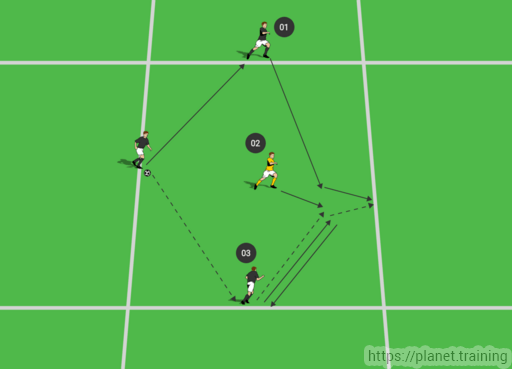
Sequence
Three black players are placed along both the shorter sides of a rectangle and along one of the longer sides. One defender is placed in the middle of the wide playing space.
The objective for the players in possession is to pass the ball forward from one longer side toward the other through wide passes and moving deep with diagonal runs to receive from the shorter side and behind the defender. A second objective is to move wide to support the possession phase. The defender must close the passing lanes in the middle.
Transitions
Tta: if the defender (2), who can only intercept the passes, wins the ball, he must pass forward to the incoming player who's moving deep (1), exploiting the space toward the free side, to start the sequence from the opposite longer side. Then he must move wide to be an option for the next sequence Ttd: the black player (3) who missed the pass becomes defender in a 1 v 1 duel to close the forward passing option. The new defender can be active until the borderline is overcome; if he can't recover the possession, he becomes defender of the next sequence. Variation: the coach can decide the defender between the players 1 and 3.
Eye on: close the passing lanes, reaction speed, pass forward to save the possession.
Exercise 9: 3 v 1 and 1 + 1 v 1 transition (5)

Sequence
Three black players are placed along both the shorter sides of a rectangle and along one of the longer sides. One defender is placed in the middle of the wide playing space.
The objective for the players in possession is to pass the ball forward from one longer side toward the other through wide passes and moving deep with diagonal runs to receive from the shorter side and behind the defender. A second objective is to move wide to support the possession phase. The defender must close the passing lanes in the middle.
Transitions
Tta: if the defender (2), who can only intercept the passes, wins the ball, he must pass forward to the incoming player who's moving deep, exploiting the space toward the free side, to start the sequence from the opposite longer side. Then he must move wide to be an option for the next sequence Ttd: the black players, 3 or 1, can be defenders of the 1 v 1 duel. The player (3) who missed the pass becomes defender in a 1 v 1 duel to close the forward passing option in the picture. The new defender can be active until the borderline is overcome; if he can't recover the possession, he becomes defender of the next sequence. The player 1 changes the direction and he becomes a wide option for the next sequence.
Eye on: close the passing lanes, reaction speed, recover the space, pass forward to save the possession.
Exercise 10: 3 v 1 and momentary 2 v 1 transition
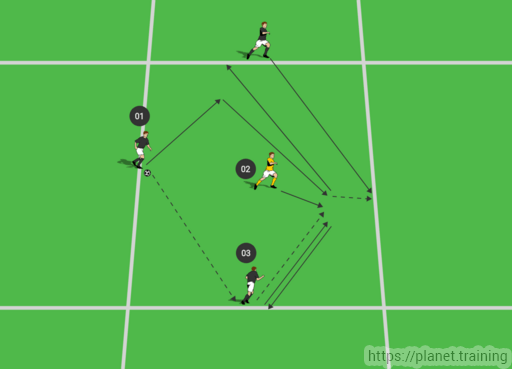
Sequence
Three black players are placed along both the shorter sides of a rectangle and along one of the longer sides. One defender is placed in the middle of the wide playing space.
The objective for the players in possession is to pass the ball forward from one longer side toward the other through wide passes and moving deep with diagonal runs to receive from the shorter side and behind the defender. A second objective is to move wide to support the possession phase. The defender must close the passing lanes in the middle.
Transitions
Tta: if the defender (2), who can only intercept the passes, wins the ball, he must pass forward to the incoming player who's moving deep, exploiting the space toward the free side, to start the sequence from the opposite longer side. Then he must move wide to be an option for the next sequence Ttd: the coach decides who is the defender between the black players 3 or 1. The player (3) who missed the pass becomes defender in a 1 v 1 duel to close the forward passing option in the picture. The player (1) helps the transition to attack phase, creating a momentary 2 v 1 duel in the middle and passing the ball forward, before running wide to be an option for the next sequence.
Eye on: close the passing lanes, reaction speed, recover the space, pass forward to save the possession.
Exercise 11: 4 v 1 and 1 v 1 transition (1)

Sequence
Three black players are placed along both the shorter sides of a rectangle and along one of the longer sides. One defender and one more attacking player are placed in the middle of the wide playing space.
The objective for the players in possession is to pass the ball forward from one longer side toward the other through wide and inside passing sequences and moving deep with diagonal runs to receive the ball from the center player. A second objective is to move wide to support the possession phase. The defender must mark the center opponent on trying to anticipate him.
Transitions
Tta: if the defender wins the ball, he must dribble toward the same side where the last pass was coming from. Ttd: the player who made the last pass (1) and who is now running to change side of play, must change direction, try to recover the space against the player now in possession and tackle him to recover the ball; if he is not able, he becomes the defender of the next sequence. The center player can change after a fixed limit of time.
Eye on: mark the opponent on, recover the space, tackle the opponent, dribble the ball away to save the possession.
Exercise 12: 4 v 1 and 1 v 1 transition (2)

Sequence
Three black players are placed along both the shorter sides of a rectangle and along one of the longer sides; they are all numbered. One defender and one more attacking player are placed in the middle of the wide playing space.
The objective for the players in possession is to pass the ball forward from one longer side toward the other through wide and inside passing sequences and moving deep with diagonal runs to receive the ball from the center player. A second objective is to move wide to support the possession phase. The defender must mark the center opponent on trying to anticipate him.
Transitions
Tta: if the defender wins the ball, he must dribble toward the easiest side of the rectangle to save the possession. Ttd: the coach calls the number of the defending player who is now running to change side of play (3 in the picture), changing the direction, try to recover the space against the player now in possession and tackle him to recover the ball; if he is not able, he becomes the defender of the next sequence. The center player can change after a fixed limit of time.
Eye on: mark the opponent on, recover the space, tackle the opponent, dribble the ball away to save the possession.
Exercise 13: 4 v 1 and 1 v 1 transition (3)

Sequence
Four black players are placed along the sides of a rectangle; one defender is placed in the middle of the deep playing space.
The objective for the players in possession is to alternate the passing sequences with two wide passes and one deep toward a teammate who must be free behind the defender. At every vertical passing attempt, two players must exchange their positions; the player who made the pass and the nearest teammate. The defender must intercept the ball in the middle.
Transitions
Tta: if the defender wins the ball, he must dribble toward the free side of the rectangle to save the possession. The free side is the one left by one of the players who is exchanging the positions. Ttd: the player who made the last pass and who is now running to change side of play, must change direction, try to close the space against the player now in possession and tackle him to recover the ball; if he is not able, he becomes the defender of the next sequence.
Eye on: close the space, tackle the opponent, dribble the ball away to save the possession.
Exercise 14: 4 v 1 and 1 v 1 transition (4)

Sequence
Four black players are placed along the sides of a rectangle; they are all numbered. One defender is placed in the middle of the deep playing space.
The objective for the players in possession is to alternate the passing sequences with two wide passes and one deep toward a teammate who must be free behind the defender. At every vertical passing attempt, two players must exchange their positions; the player who made the pass and the nearest teammate. The defender must intercept the ball in the middle. The black players rotate their positions if a transition to defend situation must be organized.
Transitions
Tta: if the defender wins the ball, he must dribble toward the free side of the rectangle to save the possession. The free side is the one left by one of the players who is exchanging the positions. Ttd: the coach calls the number of the defending player (4 in the picture) who must try to recover the space against the player now in possession and tackle him to recover the ball; if he is not able, he becomes the defender of the next sequence.
Eye on: close the space, tackle the opponent, dribble the ball away to save the possession.
Exercise 15: 4 v 1 and 1 v 1 transition (5)
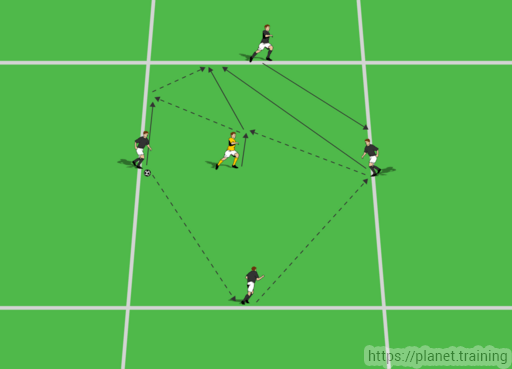
Sequence
Four black players are placed along the sides of a rectangle; one defender is placed in the middle of the deep playing space.
The objective for the players in possession is to alternate the passing sequences with two wide passes and one deep toward a teammate who must be free behind the defender. At every vertical passing attempt, two players must exchange their positions; the player who made the pass and the nearest teammate. The defender must intercept the ball in the middle.
Transitions
Tta: if the defender wins the ball, he must play a 1 - 2 passing combination with the nearest outer player and toward the free side of the rectangle to save the possession. The free side is the one left by one of the players who is exchanging the positions. Ttd: the player who made the last pass must change direction, try to intercept the pass toward the one now in possession and tackle him to recover the ball; if he is not able, he becomes the defender of the next sequence.
Eye on: intercept the pass, tackle the opponent, play fast passing combination to save the possession.
Exercise 16: 4 v 1 and 1 v 1 transition (6)
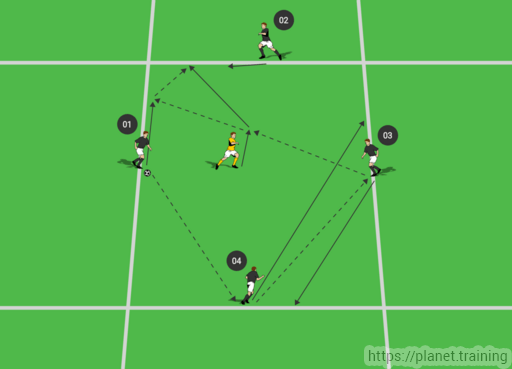
Sequence
Four black players are placed along the sides of a rectangle; they are all numbered. One defender is placed in the middle of the deep playing space. The objective for the players in possession is to alternate the passing sequences with two wide passes and one deep toward a teammate who must be free behind the defender. At every vertical passing attempt, two players must exchange their position; the player who made the pass and the nearest teammate. The defender must intercept the ball in the middle.
Transitions
Tta: if the defender wins the ball, he must play a 1 - 2 passing combination with the nearest outer player and toward the free side of the rectangle to save the possession. The free side is the one left by one of the players who is exchanging the positions. He must pay attention to pass toward an outer player who is not identified as defender. Ttd: the coach calls the number of the defending player (2 in the picture) who must play a 1 v 1 duel to anticipate the opponent and to recover the ball; if he is not able, he becomes the defender of the next sequence. The defense moves depends on the number called by the coach; it can be a 1 v 1 front duel or the defender must recover the space or close it, if he is further from the ball carrier.
Eye on: 1 v 1 duel, tackle the opponent, play fast passing combination to save the possession.
Exercise 17: 4 v 1 and 1 v 2 transitions
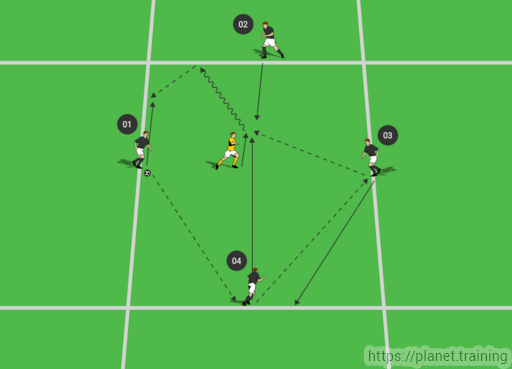
Sequence
Four black players are placed along the sides of a rectangle; they are all numbered. One defender is placed in the middle of the deep playing space. The objective for the players in possession is to alternate the passing sequences with two wide passes and one deep toward a teammate who must be free behind the defender. At every vertical passing attempt, two players must exchange their position; the player who made the pass and the nearest teammate. The defender must intercept the ball in the middle.
Transitions
Tta: if the defender wins the ball, he must dribble the ball toward a free side and then pass back to an outer player depending on the numbers the coach called to play the transition to defend. He must pay attention to pass toward an outer player who is not identified as defender. Ttd: the coach calls the number of the defending players (even numbers or odd numbers) to play a 2 v 1 duel to recover the ball; if they are not able, the defender who was wrongly placed against the opponent become defender in the next sequence too. The defense moves depends on the numbers called by the coach.
Eye on: direct duels against the outnumbered opponent, double the mark fast, play fast passing combination to save the possession.


